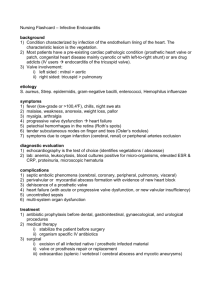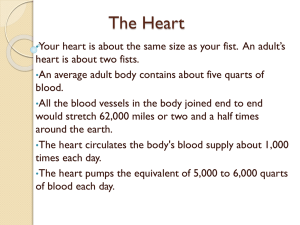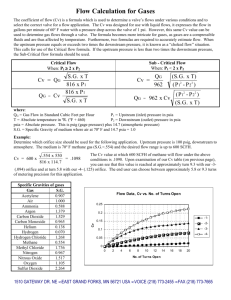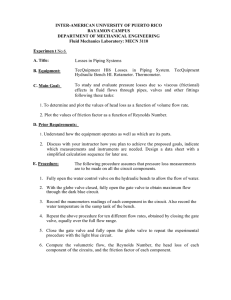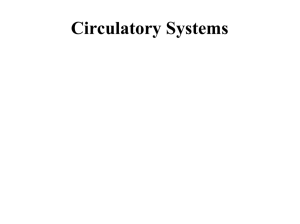Development of an advanced mechanical heart valves piv test bench.
advertisement
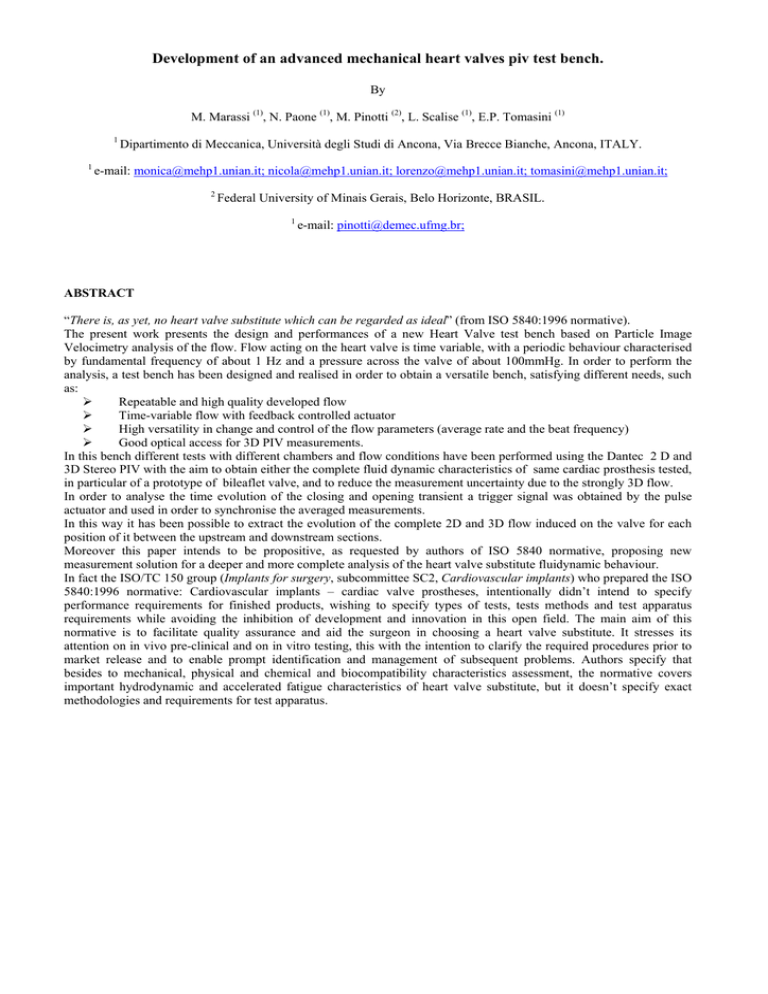
Development of an advanced mechanical heart valves piv test bench. By M. Marassi (1), N. Paone (1), M. Pinotti (2), L. Scalise (1), E.P. Tomasini (1) 1 1 Dipartimento di Meccanica, Università degli Studi di Ancona, Via Brecce Bianche, Ancona, ITALY. e-mail: monica@mehp1.unian.it; nicola@mehp1.unian.it; lorenzo@mehp1.unian.it; tomasini@mehp1.unian.it; 2 Federal University of Minais Gerais, Belo Horizonte, BRASIL. 1 e-mail: pinotti@demec.ufmg.br; ABSTRACT “There is, as yet, no heart valve substitute which can be regarded as ideal” (from ISO 5840:1996 normative). The present work presents the design and performances of a new Heart Valve test bench based on Particle Image Velocimetry analysis of the flow. Flow acting on the heart valve is time variable, with a periodic behaviour characterised by fundamental frequency of about 1 Hz and a pressure across the valve of about 100mmHg. In order to perform the analysis, a test bench has been designed and realised in order to obtain a versatile bench, satisfying different needs, such as: Repeatable and high quality developed flow Time-variable flow with feedback controlled actuator High versatility in change and control of the flow parameters (average rate and the beat frequency) Good optical access for 3D PIV measurements. In this bench different tests with different chambers and flow conditions have been performed using the Dantec 2 D and 3D Stereo PIV with the aim to obtain either the complete fluid dynamic characteristics of same cardiac prosthesis tested, in particular of a prototype of bileaflet valve, and to reduce the measurement uncertainty due to the strongly 3D flow. In order to analyse the time evolution of the closing and opening transient a trigger signal was obtained by the pulse actuator and used in order to synchronise the averaged measurements. In this way it has been possible to extract the evolution of the complete 2D and 3D flow induced on the valve for each position of it between the upstream and downstream sections. Moreover this paper intends to be propositive, as requested by authors of ISO 5840 normative, proposing new measurement solution for a deeper and more complete analysis of the heart valve substitute fluidynamic behaviour. In fact the ISO/TC 150 group (Implants for surgery, subcommittee SC2, Cardiovascular implants) who prepared the ISO 5840:1996 normative: Cardiovascular implants – cardiac valve prostheses, intentionally didn’t intend to specify performance requirements for finished products, wishing to specify types of tests, tests methods and test apparatus requirements while avoiding the inhibition of development and innovation in this open field. The main aim of this normative is to facilitate quality assurance and aid the surgeon in choosing a heart valve substitute. It stresses its attention on in vivo pre-clinical and on in vitro testing, this with the intention to clarify the required procedures prior to market release and to enable prompt identification and management of subsequent problems. Authors specify that besides to mechanical, physical and chemical and biocompatibility characteristics assessment, the normative covers important hydrodynamic and accelerated fatigue characteristics of heart valve substitute, but it doesn’t specify exact methodologies and requirements for test apparatus. 1. INTRODUCTION Nowadays Heart valve replacement can be considered a common clinical practice. But the surgical procedure for the installation of a Mechanical Heart Valves (MHV) has high risks for the patient undergoing the procedure and high costs for the structure responsible for the installation. MHVs represent a challenging design problem, despite their simple structure and have high costs. In fact, their design is a complex problem being reliability, costs, structural and hydraulic performances of the valve key points. Moreover the biocompatibility of the prosthesis is a fundamental parameter that must be taken into account, particularly the fluid-dynamic effects on blood components (platelets, emacrocytes, etc.) must be accurately studied to assure the absence (or at least minimum) of damages caused by the prosthesis itself. Bileaflets mechanical valve, introduced by St. Jude in 1977, can be considered a successful valve design having improved the performances of previously realised heart valves. Still this design presents problems such as overgrowth, trombogenicity and hemolysis (Horstkotte and Bodnar, 1992). MHV can generate to dangerous effect patient’s health: first, turbulence in the blood flow and this is related to thrombus formation (Stein and Sabbah, 1974; Edmunds, 1982), second the hemolysis caused by the alteration of the physiologic cardiovascular environment’s fluid dynamics. Critical value of Reynolds shear stress which lyse red blood cells has been individuated (Blackshear, 1972; Paul et al., 1999) and the sub lethal damage occurring at lower shear stress values has been demonstrated. In general, it can be demonstrated that high levels of shear stress, acting for a long period can damage red cells and platelets (hemolysis), while stagnation areas can determine thrombus formation (thromogenicity). A possible solution would be the use of biological valves, which have not such problems, but do not guarantee the necessary reliability in particular for the application on children. A complete fluid-dynamic analysis of MHV is therefore necessary in order to verify or optimise the valve behaviour and to avoid potential damages. The present work is aiming to present the design and performances of a completely new Heart Valve test bench based on Particle Image Velocimetry analysis of the flow. Flow acting on the heart valve is time variable, with a periodic behaviour characterised by fundamental frequency of about 1 Hz and a pressure across the valve of about 100mmHg. It is authors opinion that the use of PIV measurement methodology as part of heart valve substitute (HVS) testing and performance assessment, providing a deep and complete fluidynamic description of the HVS, therefore providing a basic information for optimisation of the product before pre-clinical in vivo tests and market release, so that eventual following problems could be better identified and managed. In this bench different tests with different chambers and flow conditions have been performed using the Dantec 3D Stereo PIV with the aim to obtain either the complete fluid dynamic characteristics of the bileaflet valve tested and to reduce the measurement uncertainty due to the strongly 3D flow. 2. MATERIAL, METHODS AND RESULTS. All the experiment reported in the present paper have been conducted on a pre-commercial prototype bealeflet mechanical heart valve similar to the one reported in figure 1, which can be considered the commercially dominating prosthetic valve and on a biological valve substitute (PIV-3D pulsatile tests). The mechanical valve has two semicircular leaflets, which divide the area available for forward flow into three regions: two lateral orifices and a central orifice. Its external diameter is 27 mm, while its internal diameter is 24 mm. A detailed analysis of the velocity profiles , turbulence and shear stresses of this MHV is reported in Castellini et al. (2001). From this paper the complete analysis using a laser Doppler velocimeter has been presented and its potential for fluidynamic characterisation of MHV has been explained. In the following the Particle Image Velocimetry is presented as a powerful measurement technique for the fluidynamic characterisation of cardiac valve prosthesis. In fact this is the only technique allowing the measurement of full instantaneous velocity field upstream and downstream the valve. Velocity gradient as well turbulence level can be obtained form the same set of measured data and time evolution of these data can be obtained. In order to perform the analysis, a test bench has been designed and realised in order to obtain a versatile bench able to provide repeatable and high quality developed flow (steady-state flow), pulsatile flow, high versatility and control of the flow parameters (such as: mean volume flow, mean pressure difference, cycle rate, compliance). Moreover the test bench has been realised with the purpose to offer, as much as possible, similar conditions to the ones defined as physiological and it can provide a good compatibility of the fluid with biological tissues, so that biological heart valve substitute have been tested too. Particular stress has been put on the realisation of geometrical and optical solution for realising the best PIV measurements. So that three solutions will be presented in the following. Figure 1. 2.1 The bi-leaflet valve. Measurement conditions and fluidynamic similitude. In all the tests carried out for the present article, the working fluid was water with seeding particles made by glass spheres (mean diameter 10 µm, density: 1.2 –1.4 g/cm3), with viscosity at temperature T=15°was 1.14x10-3 Ns/m. Each PIV test was carried out working with 8 – 11 particles present in the interrogation area. The Windkessel model (Westerhof 1971) has been taken into account to simulate arterial systemic load; two resistances and a compliance have been designated, developed and calibrated choosing as references the values reported in literature, see J. D. Schaub et al. Compliance has been realised with the solution reported in figure 2 (left). Pressure-to-volume relation has been measured and it is reported in figure 2 (right). With this solution, compliance could be easily modified according to desired tests conditions. pressure vs volume 9 8 pressure, kPa 7 6 5 4 3 2 1 0 0.00015 0.0002 0.00025 0.0003 3 volume, m Figure 2. Compliance realisation (left) and pressure vs volume characteristic (right). Circuit resistance can be varied as reported in figure 3-a. A photo of the resistance is reported in figure 3-b: it is composed by small lead spheres and a tube (internal diameter: 20 mm). Two of such resistances can be used to realise a Windkessel load. Measurement results and steady state and pulsatile testing conditions obtained with water as working fluid could be translated in physiological domain (blood as fluid) taking in account the principle of dynamic similarity [L. J. Temple et al. (1964)]. In fact, it is demonstrated that the pulsatile flow characteristics of a system can be defined in terms of two parameters: First one is the Reynolds number (Re), the second one is α , a stated quantity which is used to describe pulsatile flow and which is dependent on the pulse rate (f). Reynolds number and α parameter are defined as follows: Re = 4 ρQ πµd α =d (eq. 1); fρ µ (eq. 2) ρ is fluid density (Kg/m3), µ is dynamic viscosity (Ns/m) of fluid ,d is the diameter – for a pipe - (m), Q is flow rate (l/min) and f is pulse rate (pulse/min). According to Temple a test bench using water as working fluid, is equivalent to the same test conducted utilising blood on the same test bench, if and only if, Reynolds numbers (for water and blood tests) and α-parameters have the same values. Therefore it is necessary to impose the following conditions: 4 ρ w Q w 4 ρ b Qb = πµ w d w πµ b d b dw (eq. 3); fwρw µw = db fb ρb µb (eq. 4); (w for water and b for blood ). Being the density for water and blood approximately the same ( ρ w = ρ b =1000Kg/m3) and using the same diameter of the pipe (d=25 mm)we can obtain the two following relations: fw µw = fb µb Qw µ w = Qb µ b (eq. 5); (eq. 6); these equations have been taken in account to set flow rate and pulse frequency. µw has been placed equal to 1.14 x10-3 Ns/m at temperature of 15°C and µb to 4.0x10-3 Ns/m at temperature of 36°C; so that the ratio between µw/µb is equal to 0.285. Resistance 1 40,0 dP (mmHg) 30,0 20,0 10,0 0,0 0 50 100 150 200 Q (ml/s) a) Figure 3. b) Resistance; a) Pressure vs Flow rate of the first resistance; b) photo of the resistance. Cameras, 1024 X 1280 pixel, have been moved using a X, Y and Z translation stages. Resolution of these stages was 0.25 mm, while maximum displacement was 25 mm for each direction. The PIV system configuration was as follows: • 50 mJ, New Wave Solo ND-Yag laser operating at 532 nm with 4-6 nanosecond pulses . • A double-frame CCD camera having resolution of 1280x1024 pixels, 12 bit. • 60-mm Nikkor lenses • 2100 Flowmap processor • 2DFlow Manager software for post analysis 2.2 Measurement set-up. 2.2.1. PIV 2D on a steady-state forward-flow test bench. Internal diameter of the steady-flow testing set-up was: 27 mm upstream and 25 mm downstream the valve. The available flow rate values from the test bench were ranging from 6 l/min up to 14 l/min. A flow straightened has been placed upstream at 83 mm from the MHV in order to obtain a relatively no-disturbed flow on the MHV. Some of the results obtained with the present set-up are reported for a 8 l/min flow-rate, that considering equation 5) is equivalent to about 28 l/min of blood flow. A photo of optical access utilised is reported in figure 4 and presented in Castellini et al. (2001).The choice of an optical chamber based on a thin wall pipe allowed to minimise the diffraction effects on the laser light passing through curved interfaces between different materials (with different refraction index). In fact, the thickness of the pipe, which is about 100 µm, eliminates the effects of the curvature and the subsequent image distortion. Such condition allows to gain a large freedom in the choice of working fluid for the circuit. Figure 4 reports the adopted solution. Figure 4. The optical access on the valve. A typical result is reported in figure 5 for mean steady flow-rate of 8 l/min. Velocity maps are referred to a diametral plane perpendicular to the rotational axis of the valve leaflets. Time intervals between laser pulses have been varied between 200 and 800 ms, averaging on 10 images has been carried out. In this testing conditions, axial velocity ranges between 0 - 0.5 m/s (upstream) and 0 – 1 m/s (downstream). Radial component of the velocity assumes values in the interval: -0.1 – 0.1 m/s (upstream) and –0.3 – 0.3 m/s (downstream). Upstream the valve it is possible to note the boundary layer effect in a low turbulence flow, which is not fully developed. Downstream the valve it is evident the double wake of the two leaflets. The flow is not perfectly symmetric, probably due to some small differences in the positioning of one of the leaflets. A complete analysis of the mechanical valve substitute of figure 1 has been reported in Castellini et al. (2001). 1 m/s (a) Figure 5. 1m/s (b) Axial velocity profiles up-stream (a) and down-stream (b) the valve on a diametral plane perpendicular to the rotational axis of the valve leaflets. While the proposed optical access is resolving the index matching problem and allowing good PIV-2D measurements in. steady-state testing conditions, it presents two main limitations: The use of a cubic chamber, containing the thin pipe, does not allow the 3D-PIV measurements. The use of a thin transparent pipe in pulsatile flow conditions generates the collapsing and frequent breakage of the pipe itself. Therefore this set-up has been modified for working in pulsatile flow conditions and a new optical access has been realised. 2.2.1. PIV 2D on a pulsatile flow test bench. With this second set-up the previous measurement test bench has been adapted to pulsatile flow. A detail of the HMV measurement chamber is reported in figure 6 (left). Main difference respect to the previous one is that the thin pipe has been removed considering the non stationary flow conditions. The complete hydraulic test bench is reported on figure 6 (right) and is composed by: (1) constant head reservoir, (2) pulse generator, (3) optical access, (4) compliance, (5) regulation valve (6) flowmeter for mean flow-rate control, (7) discharge tank, (8) pump. In this first time the Windkessel load has been simulated by coupling compliance and regulation valve. 1 FLOW CARDIAC PROSTHESIS 2 3 4 5 6 7 8 a) Figure 6. b) PIV-2D pulsatile flow optical access (a) and hydraulic test bench (b). In order to analyse the time evolution of the closing and opening transient a trigger signal was obtained by the pulse actuator and used in order to synchronise the averaged measurements. The volumetric pulse generator is reported in figure7. Figure 7. Pulse generator. A complete monitoring of working conditions has been carried out. The values of the electro-mechanical actuator position shaft and its controlling voltage have been analysed. Flow-rate (mean and peak values) and valve leaflets positions have been measured. The problem of choosing the best triggering signal for synchronising the PIV system acquisitions with different pulsatile flow states has been solved using a laser Doppler vibrometer for correlating the leaflets position with the pulse generator voltage control signal. This task has been resolved using a laser Doppler Vibrometer, because it is not possible to use traditional contact sensor Moreover, by using laser transducers some practical troubles remain: 1) leaflets are very light and small, therefore they are difficult to be addressed; 2) their motion is complex; 3) leaflets have different dynamics, therefore both of them have to be monitored. In figure 8, axial velocity profiles upstream and downstream the MHV are reported when a mean flow-rate of 1.43 l/min and a frequency repetition of the pulse generator of 0.4 Hz are set. In figure 9 a second example of velocity map evolution in diametrical plane of the valve is shown for mean flow-rate of 9 l/min and a frequency repetition of 1.23 Hz. In particular some “samples”, obtained with a different delay with respect to the trigger, are illustrated. It is possible to note the typical propagation effect of lateral vortex induced by the aperture of the valve. The vortex propagate until the “stationary” conditions are reached, while a similar effect appears upstream the flow at the valve closure. The fast transient of the valve closure presents an interesting behaviour: during this period the velocity values locally increase and large values of shear stress could be generated. The magnitude and the duration of shear stress, that influence the onset and the severity of damage, can be calculated, and different geometry can be tested in order to estimate the less damaging solution t= 0 s t= 0.125 s t= 0.25 s t= 0.50 s t= 0.75 s t= 1 s t= 2 s t= 2.125 s t= 2.375 s Figure 8. Time evolution of velocity profiles (axial velocity component) upstream and downstream the valve as function of the leaflets position (flow-rate 1.43 l/min, measured on a diametral plane perpendicular to the rotational axis of the valve leaflets, t=0 s maximum valve aperture) . t=0.4 s t=0.45 s t=0.5s t=0.55 s t=0.6 s t=0.65 s t=0.7 s t=0 s t=0.1 s t=0.3 s t=0.2 s Figure 9.: Time evolution of flow-field upstream and downstream the valve vs the time histories of the flow rate and of the valve position. 2.2.2. PIV 3D on a pulsatile flow test bench. The principal aim of this next step was to perform 3D stereoscopic PIV measurement in a new test bench: it has been designed and realised taking in account to develop a dedicate optical access for performing 3D measurement and moreover to can be able to respect the conditions imposed by the International Standard ISO 5840 in the cardiac prosthesis testing. In fact, we have checked the impossibility to measure in 3D dimension by using the previous test benches with rectangular optical access; it was not-suitable to perform this kind of measurement, because of a strong image distortion and a real impossibility to carry out cameras calibration with any kind of dot-target. Moreover, working pipe has been introduced and we have tested a integral bovine pericardium cardiac bioprosthesis (BCB), see an example in figure 10. A prismatic box with trapezoidal section (73,5x65x50 mm) was realised; its oblique sides are inclined of 45° respect to perpendicular height of box section, in this way optical access is resulted nearly normal to the view direction of cameras in order to minimize index of refraction effect [Dantec, 2000]. Two circular holes of nominal diameter of 45 mm has been carried out to place the pipe; the latter had a nominal outside diameter of 45 mm and different inside diameter (di)and thickness (s); respectively upstream di =23 mm and s=11mm, downstream di =27 mm and s=9 mm. The upstream length of the pipe has been defined in according to obtain in the cardiac prosthesis testing section a flow completely developed, moreover a standard nozzle in accordance with the International Standard ISO 5840 has been used to characterize flow-measuring equipment A schematic of the new optical set-up is shown in figure 11; a photo of prismatic box is showed in figure 12. Figure 10. Example of bovine pericardium cardiac bioprosthesis The hydraulic set-up is equal to the previous one, besides pressure tabs have been drawn up and located one pipediameter upstream and three pipe-diameters downstream from the midplane of the cardiac prosthesis testing section; in this way we will provide (in the future) a measurement of pressure waveform during working conditions and a calibration of Windkessel load in the right manner to perform testing in real physiological conditions [International Standard ISO 5840].The whole set-up has been integrated with the described trigger control system and 3D stereoscopic PIV system for acquisition and post-processing-(3D PIV FlowManager; from Dantec Dynamics). The stereoarrangement of the digital cameras is showed in figure 11; the cameras have been placed at a distance of d0= 287 mm from the object plane and correspondent Scheimpflug condition α has been calculated (α =14.8°). A special calibration dot-target of 50x50 mm with one zero marker ( diameter of 0.675) and 4 axis markers (diameter equal to 0.325) was designed and produced; dot spacing was fixed to 1.25 mm and main marker diameter was 0.5 mm. The cameras calibration was performed both upstream and downstream of the interest section, in two symmetrical configurations ( see figure 11). To properly calibrate the stereo imaging arrangement,box and pipe have been filled with water while the target was in place. The target was moved to two positions about the z=0 location ( Z=-1.00 mm, Z= +1.00 mm) and imaged at each position. In figure 13 it is showed a typical view of target obtained from one camera and related calibration image used to find the calibration coefficients: in the figure 13 is also shown a particular of result of calibration calculation in which it is evident a good correspondence between image plane e object plane after calibration.. CCD PLANE OBJECT PLANE θ α LENS PLANE F low Flow a) Figure 11. Figure 12 b) Optical set-up upstream (a) and downstream (b) the BCP Photo of prismatic box, which represent the new optical access. Figure 13. Calibration target image and relative calibration results The 3D measurements have been performed at a mean flow rate of 1,43 l/min of water and a frequency repetition of 0.4 Hz (pulse rate of 24 per minute); the mean time-per-cycle was evaluate in 2.5 sec, the PIV acquisitions have been performed setting trigger with a incremental delay of 0.125 sec; in this way we could follow the complete opening and closing transient of the tested BCB; the time interval between pulse was varied from 200 µs upstream, to 100 µs downstream the BCB. A typical image obtained is showed in the figure 14. Figure 14. Example of a typical acquired images to both cameras Application of the stereo-PIV methodology has been carried out a very good signals within the whole cycle, in fact PIV together Trigger control system has been able to reconstruct this dynamical phenomenon; typical instantaneous measurements of the three components of velocity along the downstream cross-section are shown in figure 15. Figure 15. 3D Chart of downstream cross-section In figures 16 and 17 (a and b), axial instantaneous velocity profiles in the midplane of cross-section were shown related to various time instants which are correlated with opening and closing time intervals. It was evident that it could observed high instantaneous velocity gradients. 3.0 Velocity (m/s) 2.5 2.0 axial comp. at istant t=0.00 s 1.5 axial comp.at istant t=0.125 s 1.0 axial comp. at istant t=0.25 s 0.5 axial comp. at istant t=0.375 s 0.0 -15.0 -10.0 -5.0 -0.5 0.0 5.0 10.0 15.0 -1.0 pixel Figure 16. Upstream velocity profile of axial component in various time instants. 3.0 2.5 Velocity (m/s) 2.0 axial-comp. at istant t=0.00 s 1.5 1.0 axial-comp. at istant t=0.25 s 0.5 axial-comp. at istant t=0.125 s 0.0 -15.0 -10.0 -5.0 -0.5 0.0 5.0 10.0 axial-comp.at istant t=0.375 s 15.0 -1.0 pixel Figure 17 (a) Downstream velocity profile of axial component in various time instants (closing transient) 3.0 Velocity (m/s) 2.5 2.0 1.5 1.0 0.5 -15.0 -10.0 0.0 -5.0 -0.5 0.0 5.0 10.0 15.0 -1.0 pixel axial comp.at istant t=2.5 s Figure 17 (b) 3. axial comp.at istant t=2.375 s Downstream velocity profile of axial component in various time instants (opening transient) DISCUSSION AND CONCLUSION. Set-up realisation for PIV-3D measurement on mechanical and biological heart valve substitutes has been presented. Setup parameters, optical solution and triggering of signal for a correct and informative assessment of the fluid-dynamic proprieties of heart valve substitute has been presented. The complete upstream and downstream velocity fields are measurable for all flow conditions. Test in steady-state and pulsatile flow conditions are reported showing regions of maximum velocity and turbulence. These areas are suspected to be the responsible of the red blood cells damage (emolysis and consequent risk of thrombus formation for the patient), therefore the presence of such regions should be analysed before valve installation and the proposed testing methodology can be used as a fundamental tool for the evaluation of heart valve substitute performances. Moreover as the ISO/TC 150 group (Implants for surgery, subcommittee SC2, Cardiovascular implants) who prepared the ISO 5840:1996 normative: Cardiovascular implants – cardiac valve prostheses, has indicated in the introduction to the ISO 5840 normative PIV technique can be considered as a integrative methodology for a complete overview of valve substitute fluid-dynamic. Upstream and downstream velocity fields, velocity profile, turbulence during all the heart cycle are provided and allows technicians to deeply access all the phenomena. As shown in figure 15with a biological heart valve substitute, the proposed methodology allows a complete analysis of the valve behaviour and its consequences on fluid-dynamic. Differences in the occluder retention mechanism have been quantitatively demonstrated from the velocity profile measured in figures , 16 and 17. It is possible to note the typical propagation effect of lateral vortex induced by the aperture of the valve. The vortex propagate until the “stationary” conditions are reached, while a similar effect appears upstream the flow at the valve closure. The fast transient of the valve closure presents an interesting behaviour: during this period the velocity values locally increase and large values of shear stress could be generated. The magnitude and the duration of shear stress, that influence the onset and the severity of damage, can be calculated, and different geometry can be tested in order to estimate the less damaging solution. The valve position is influenced by the pressure distribution upstream and downstream the valve, which is produced by the whole circuit flow. Moreover the valve motion determines the local distribution of the fluid flow, which is the main responsible of the haemolysis and of thrombus formation. Authors strongly believe that with the proposed measurement methodology new advances in design and qualification of heart valve substitute is possible. Next steps in the research will focus measurement set-up conditions more close to the physiological ones providing significant values of shear stresses. 4. ACKNOLEDGEMENT. Authors deeply acknowledge the useful discussion with Dr. Castellini and the precious help of Mr. Ponzio, Mrs Virginia Santos in the preparation of the test bench. 5. REFERENCES. ISO 5840: 1996(E) , third edition (1996-11-01), Cardiovascular implants – cardiac valve prostheses. Blackshear, P.L., 1972 “Mechanical hemolysis in flowing blood”, in: Fung, Y.C. (Ed.), Biomechanics. Its Foundation and Objectives. Prentice-Hall Inc., Englewood Cliffs, NJ. Horstkotte D., Bodnar E., 1992 “Bileaflet valves”, in: Bodnar E., Freater R. (Eds), Replacement Cardiac Valves. McGraw-Hill Inc., New York, pp. 201-228. Paul R., Shugner F., Reul H., Rau G., 1999 “Recent findings on flow induced blood damage; critical shear stresss and exposure times obtained with a high shear Couette-system”, Artificial Organs 23 (7), 680. Stein P.D., Sabbah H.N.,1974 “Measured turbulence and its effect on thrombus formation”, Circulation Research 35, 608-614. L. J. Temple, R. Serafin, N. G. Calvert, and J. M. Drabble, 1964 “Principle of fluid mechanics applied to some situations in the human circulation and particularly to testing of valves in a pulse duplicator”, Thorax, 19, 261 Castellini P., Pinotti M., Scalise L. (2001) . “Development of an experimental test bench for the measurement of fluid dynamic behaviour of mechanical heart valve”, Proc. of SPIE 4263, pp. 65 - 72, January 2001, San Jose, USA. Jeremy D. Schaub, Steven C. Koenig, et al., (1999) . “Development of a flow feedback pulse duplicator system with rhesus monkey arterial input impedance characteristics” ASAIO Journal. http://www.dantecmt.com/Applications/Hydrodynamics/3dpiv_FlowMeter/Index.html “3D stereoscopic PIV based Flow Meter for fully and partially filled conduits“ (2000) M. Grigioni, C. Daniele, G. D’Avenio, V. Barbaro, 2001 “The influence of the leaflets’curvature on the flow field in two bileaflet prosthetic heart valves“ . “J. of Biomechanics 34, 613 - 621.
